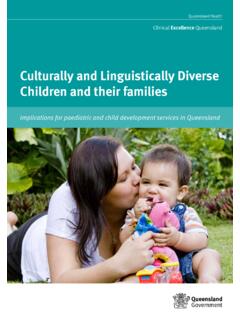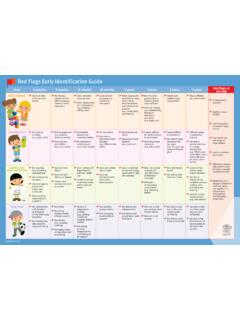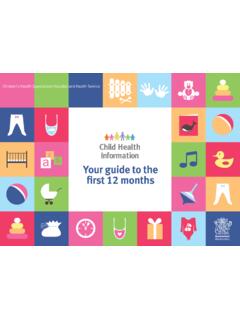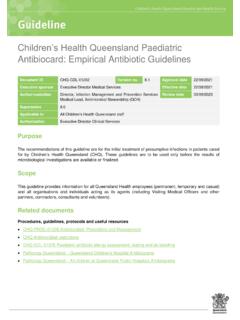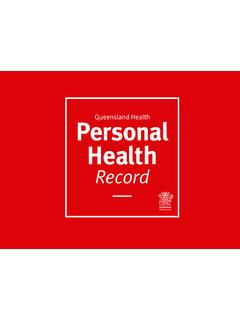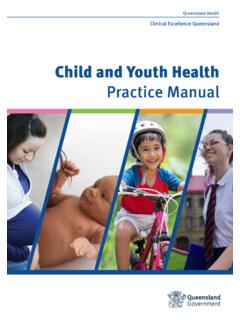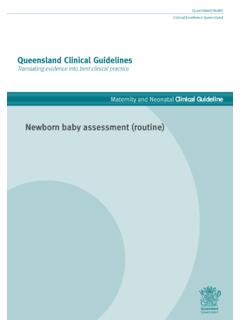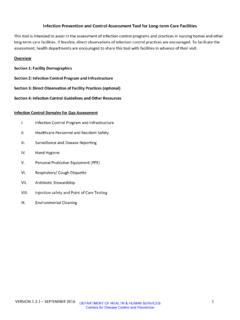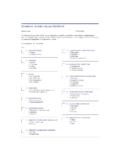Transcription of Paediatric Respiratory Assesment
1 Queensland Paediatric Emergency CareNursing Skill SheetsRespiratory assessment in childrenRespiratory assessment includes the assessment of airway patency and efficacy of in sentencesMildALL the following:Moderate accessorymuscle use andANY of the following:Severe accessorymuscle use andANY of the following:Life-threateningANY of the following:Occasional irritabilitySome limitation in ability to talk - talking in phrasesAgitated, restless, distressedMarked limitation to ability to talk - talking in words only Drowsy or unconsciousUnable to vocalise due to dyspnoeaCan walk or crawlLethargicTripod sittingLethargicTripod sittingCollapsed or exhaustedMild accessory muscle useModerate accessory muscle useSevere accessory muscle useSevere accessory muscle use or poor Respiratory effortNormal or mild tachypnoeaTachypnoeaTachypnoeaSevere tachyopnoea or bradypnoea or apnoeaNormal or mild tachycardiaTachycardiaTachycardiaCardiac arrhythmia or bradycardia (preterminal)
2 Sign)PostureBreathingNormalPaleCyanosisC yanosisSkin ColourRespiratory RateHeart RateLeast invasive to most invasiveStart your assessment with the hands off elements allowing the child to assume a position of comfort. With the assistance of caregivers to expose the chest, the following can be done without touching the infant or child: Observe the infant or child s behaviour, colour, presence of Respiratory muscle recession and categorise accordingly with the table above. Obtain the Respiratory rate. Observe for equal rise and fall of the chest.
3 Without a stethoscope listen for any sounds such as coughing, nasal congestion, snoring, grunting, wheezing or the Respiratory assessment with the hands on elements: Ensure the trachea is centred with no deviation. Auscultate the chest. Obtain and document a full set of observations including heart rate and oxygen saturations. Document your findings and seek assistance as guide to Mild, Moderate, Severe and Life-threatening Respiratory features: Respiratory assessment :Chest Auscultation If possible, it is beneficial to wait for a time when the infant or child is not crying to ensure subtle sounds are not missed.
4 For younger children you may find it helpful to first let them play with your stethoscope or integrate the use of their toys to build rapport and encourage compliance. If old enough, ask the child to sit up in bed or if they prefer on their caregiver s lap. Asking the child to take deep breath ( big breaths ) auscultate the front and back of the chest. Compare right to left in a Z pattern. Note any noises such as wheezing or crackles on the inspiratory or expiratory phase of the respiration cycle. Document your 1/2 CHQ-NSS-51013 Respiratory Assesment Developed by the State-wide Emergency Care of Children Working Group, March 2020 Children s Health Queensland Hospital and Health ServiceFor further information: Clinical assessment of the Paediatric Patient Rapid assessment / Primary and Secondary Survey / Vital Signs (QH only) Nursing Standard: Clinical Observations Considerations in Children (QH only)ALERTA silent chest is a medical emergency.
5 Seek urgent medical attention. A silent chest is suggestive of little to no gas exchange and is a warning that Respiratory failure is with stridor should be made as comfortable as possible. Take special care not to distress the child as this may exacerbate their symptoms. Guide to Normal ParametersLocation of intercostal musclesUrgently seek medical advice in the child with signs of severe or life-threatening Respiratory prompt senior nursing/medical advice in a child with moderate Respiratory distress or worsening rate (RR) (breaths/minute)Age< 1 year1-4 years5-11 years> 12 years21-4516-3516-3016-25100-15990-13980 -12960-119 Heart rate (HR) (beats/minute)
6 Other Signs of Respiratory distress in children Head bobbing in infants Tripod position Paradoxical abdominal breathing Flat affect Absence of cry GruntingWhen to escalate carePage 2/3 References: This Queensland Paediatric Emergency Nursing Skill Sheet was developed by the Emergency Care of Children working group (funded by the Queensland Emergency Department Strategic Advisory Panel) with the help of the following resources: Children s Health Queensland Hospital and Health Service. (2019b, September 26).
7 Asthma - Emergency management in children. s Health Queensland Hospital and Health Service. (2019, September 26). Bronchiolitis - Emergency management in children. s Health Queensland Hospital and Health Service . (2019, September 26). Pre-school Wheeze - Emergency management in children. , , D., Wong s nursing care of infants and children. 10th ed. 2015, Canada: Health Statewide ED Nurse Educator Committee, Pearson, N., Cole, T., & Carney, S. (Eds.). (2016). Unit 5 Respiratory . In Queensland Health: Transition Support Program - Emergency.
8 Module 3 - Paediatric Care in the Emergency Department (4th ed., pp. 68 78). State of Queensland (Queensland Health).CHQ-NSS-51013 Respiratory Assesment Developed by the State-wide Emergency Care of Children Working Group, March 2020 Page 3/3 The information contained in the Queensland Paediatric Emergency Care nursing skill sheets are intended for use by nursing staff for information purposes only. The information has been prepared using a multidisciplinary approach with reference to the best information and evidence available at the time of preparation.
9 No assurance is given that the information is entirely complete, current, or accurate in every respect. The nursing skill sheets are not a substitute for clinical judgement, knowledge and expertise, or medical advice. Variation from the nursing skill sheets, taking into account individual circumstances may be appropriate. This does not address all elements of standard practice and accepts that individual clinicians are responsible for the following: Providing care within the context of locally available resources, expertise, and scope of practice.
10 Supporting consumer rights and informed decision making in partnership with healthcare practitioners including the right to decline intervention or ongoing management. Advising consumers of their choices in an environment that is culturally appropriate and which enables comfortable and confidential discussion. This includes the use of interpreter services where necessary. Ensuring informed consent is obtained prior to delivering care. Meeting all legislative requirements and professional standards.



